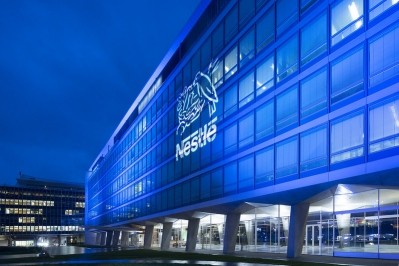Nestlé develops pea-based alt milk with ‘neutral taste’ for versatility

The FMCG major’s new line of plant-based drinks leverages the power of yellow pea to produce a high-fibre, low-sugar and fat, calcium-enriched milk alternative.
The carbon neutral brand, coined ‘Wunda’, is hitting shelves in France, Portugal, and the Netherlands, before being rolled out into other European markets.
Formulating with pea
The Wunda range, processed at Nestlé’s Sevares factory in Spain, is made from yellow peas.
The reason behind this is at least two fold: pea protein has a ‘very good nutritional quality’ as compared to most other plant proteins, and pea cultivation causes limited greenhouse gas emissions compared to other plant protein sources.
The yellow split pea is regarded one of the trendiest alternative proteins on the market. However, pea protein isolate has a bitter aftertaste, which can hold the ingredient back in food and beverage formulation.
Nestlé’s ‘plant experts’ had this challenge in mind when selecting the peas for Wunda, a company spokesperson explained. “In the case of Wunda, our R&D experts were able to leverage our expertise to develop a nutritious pea-based beverage that has a neutral taste.
“This makes the pea beverage fully versatile for everything that you would otherwise use milk for, such as baking, cooking, and drinking a hot beverage.”

To make Wunda products, Nestlé first extracts the pea protein from the yellow split pea – which it sources from France and Belgium.
This involves washing, de-hulling, and milling the peas. Next, the company splits the fibre/starch part from the protein part. The latter then undergoes a heat treatment, followed by a purification process, before being spray dried.
The pea protein is then blended with sunflower oil, fibres, salts, and vitamins, before undergoing a direct UHT process, which ‘strips off’ flavours and provides the required heat treatment to eliminate ‘harmful microorganisms’ and make the beverage commercially shelf stable.
“The product is then cooled to ambient temperature prior to filling [and] finally…aseptically filled in carton packages,” noted the firm.
Ingredients breakdown
Wunda is available in various formats, from Original in 950ml and 500ml SKUs, to Unsweetened, and Chocolate Flavour. The new brand is also trying its hand at immune-boosting shots, with 100ml bottles flavoured with Mango & Ginger and Blueberry & Mint.
Its Original product is made from pea protein, chicory root, sugar, sunflower oil, Tri-Calcium Phosphate, natural flavours, and vitamins B2, B12, and D.
“Our key ingredient is the pea protein (2.6%), which is the nutritional fundament of the recipe and brings good quality protein,” a Nestlé spokesperson told FoodNavigator.
The chicory root brings mouthfeel, while contributing to the product’s fibre content, and the ‘small amount’ (2%) of sugar brings some sweetness and body, we were told. “To five a balanced taste profile, we added sunflower oil, which brings creaminess and a ‘rounded’ taste profile to the product.”
By adding Tri-Calcium Phosphate, Nestlé is able to deliver a ‘high in calcium’ claim. The Phosphate salts also ensure the versatility of the product – in particular in hot applications. “Without it, these two ingredients would flock immediately when you put it e.g. in hot coffee,” the spokesperson explained.
Finally, natural flavours are added to ‘balance the flavour profile’, bringing in ‘milky’ and ‘creamy’ notes, and the added vitamins ensure the product is a good ‘source of’ vitamins B2, B12 and D, we were told.
From a nutritional standpoint, per 100ml of product, Wunda Original contains 1.4g fat (of which 0.1g is saturated fats), 2.4g carbohydrates (of which 2.3g is sugars), 1.9g fibre, 2.2g salt, as well as vitamins D, B2, B12, and Calcium.
Compared to its competitors, Nestlé says Wunda is the only product that achieves a Nutri-Score A with ‘green’ guideline daily amounts (GDAs) in all macronutrients according to the UK traffic light labelling scheme.
“Most other products have either too much fat (2-4%) and saturated fat and/or too [much] sugar,” noted the firm. “Also, semi-skimmed milk is worse in nutrition compared to Wunda. On top of this, Wunda is highly versatile and can be used in all applications equally to milk. This is not the case for a huge majority of the 100 other milk alternatives out there.”
A carbon neutral brand
The Wunda range has a carbon neutral claim certified by the Carbon Trust, which also measured its carbon footprint.
Wunda Original emits 0.58kg of CO₂ equivalent per litre. This is higher than some other products per litre, although as the spokesperson explained, many brands don’t disclose their carbon footprint.
Wunda’s greenhouse gas emissions are generation across its value chain, with 32% attributed to sourcing, 14% to manufacturing, 3% to packing, 35% to storage and transportation, and 11% to recycling.
The new brand puts its relatively slightly elevated carbon footprint down to its high protein content. “Wunda has 2.2g of protein per 100ml, or more than double that of many competitors. The protein source is one of the major variables in terms of emissions of plant-based beverages,” we were told.
“If we calculate CO₂ equivalent per gram of protein, then Wunda Original comes in at 0.26kg per gram of protein, which we believe is a strong performance.”
While the brand is working to reduce and remove carbon emissions within its value chain through nature-based climate solutions (insetting), it is also offsetting the remaining emissions with ‘high quality carbon credits’.
Specifically, the company has invested in the Southern Cardamom REDD+ (Reducing Emissions from Deforestation and forest Degradation) Project in Cambodia. The project teaches locals to live with the land, and helps them earn a livelihood through conservation and restoration.
“The forest protection project in Cambodia we have invested in to offset our 2021 emissions is both Verified Carbon Standard (VCS) and Climate, Community and Biodiversity (CCB) standard approved,” we were told.
“Reducing and removing greenhouse gas emissions within our own value chain is fully aligned with Nestlé’s net-zero roadmap. Offsetting of greenhouse gas emissions does not count towards Nestlé’s net-zero commitment, but is a part of the brand carbon neutrality journey.”

















